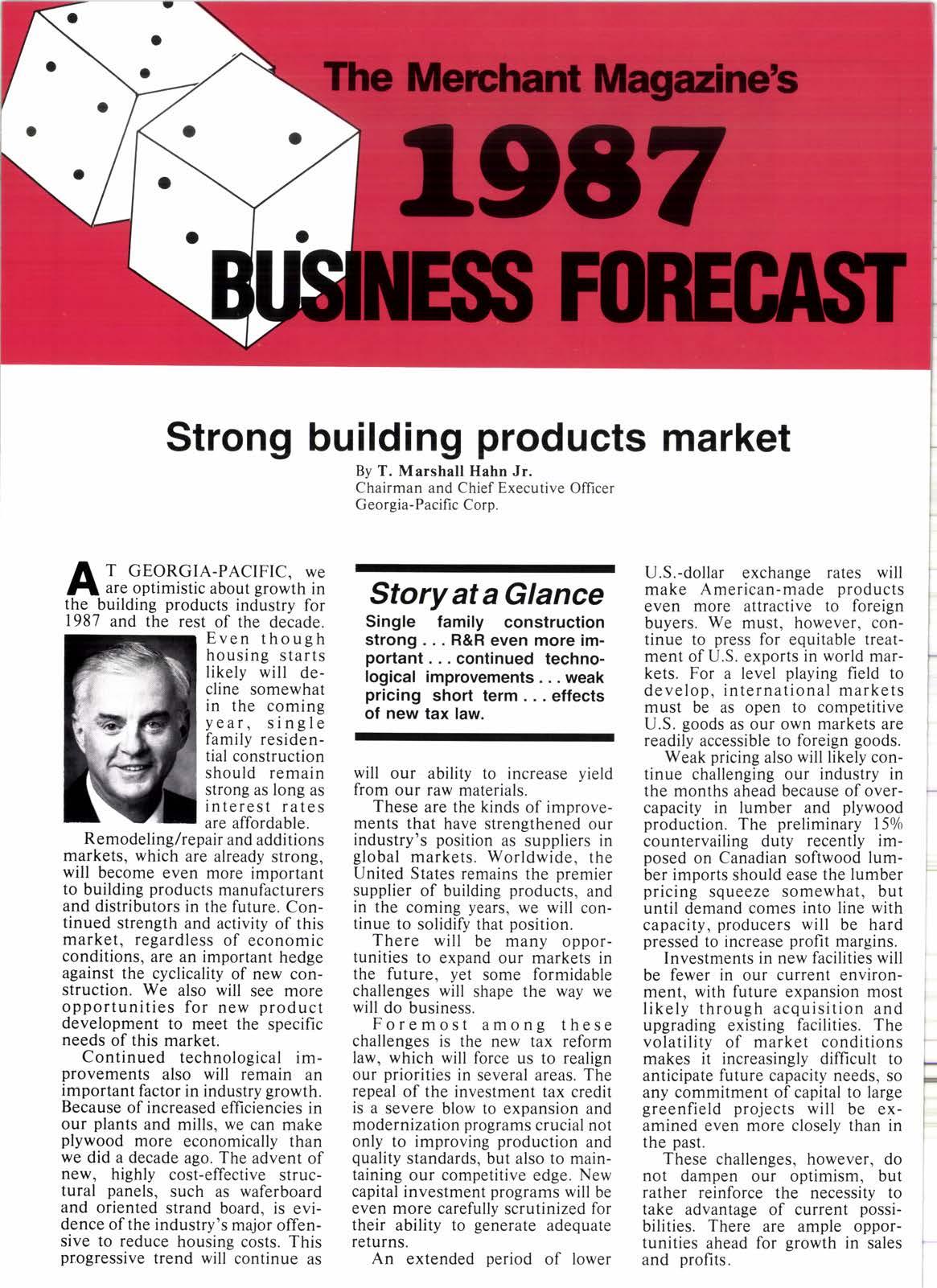
2 minute read
Strong building products market
By T. Marshall Hahn Jr. Chairman and Chief Executive Officer Georgia-Pacific Corp.
Al" :,',?#'gf; i*,? LIi?. x the building products industry for 1987 and the rest of the decade. Even though housing starts likely will decline somewhat in the coming year, single family residential construction should remain strong as long as interest rates are affordable.
Remodeling /repair and additions markets, which are already strong, will become even more important to building products manufacturers and distributors in the future. Continued strength and activity of this market, regardless of economic conditions, are an important hedge against the cyclicality of new construction. We also will see more opportunities for new product development to meet the specific needs of this market.
Continued technological improvements also will remain an important factor in industry growth. Because of increased efficiencies in our plants and mills, we can make plywood more economically than we did a decade ago. The advent of new, highly cost-effective structural panels, such as waferboard and oriented strand board, is evidence of the industry's major offensive to reduce housing costs. This progressive trend will continue as
Story at a Glance
Single family construction strong . . . R&R even more important. .. continued technological improvements.. weak pricing short term... effects of new tax law.
will our ability to increase yield from our raw materials.
These are the kinds of improvements that have strengthened our industry's position as suppliers in global markets. Worldwide, the United States remains the premier supplier of building products, and in the coming years, we will continue to solidify that position.
There will be many opportunities to expand our markets in the future, yet some formidable challenges will shape the way we will do business.
Foremost among these challenges is the new tax reform law, which will force us to realign our priorities in several areas. The repeal of the investment tax credit is a severe blow to expansion and modernization programs crucial not only to improving production and quality standards, but also to maintaining our competitive edge. New capital investment programs will be even more carefully scrutinized for their ability to generate adequate returns.
An extended period of lower llf e ARE forecasting a stron- lU ger economy in 1987 than in 1986,whichhas turned out to be relatively sluggish. Howi ever, mildly ris: ing mortgage interest rates, overbuilding in such sectors as offices and apartments, and the negativeeffects of tax reform on income property construction year.should reduce activity in the next
U.S.-dollar exchange rates will make American-made products even more attractive to foreign buyers. We must, however, continue to press for equitable treatment of U.S. exports in world markets. For a level playing field to develop, international markets must be as open to competitive U.S. goods as our own markets are readily accessible to foreign goods.
Weak pricing also will likely continue challenging our industry in the months ahead because of overcapacity in lumber and plywood production. The preliminary l5% countervailing duty recently imposed on Canadian softwood lumber imports should ease the lumber pricing squeeze somewhat, but until demand comes into line with capacity, producers will be hard pressed to increase profit margins.
Investments in new facilities will be fewer in our current environment, with future expansion most likely through acquisition and upgrading existing facilities. The volatility of market conditions makes it increasingly difficult to anticipate future capacity needs, so any commitment of capital to large greenfield projects will be examined even more closely than in the past.
These challenges, however, do not dampen our optimism, but rather reinforce the necessity to take advantage of current possibilities. There are ample opportunities ahead for growth in sales and profits.
Real gross national product is forecast to rise 3.6% from fourthquarter 1986 to fourth-quarter 1987, compared to an estimated 2.70lo during 1986. Fixed mortgage interest rates are forecast to rise from an average of close to l0o/o in fourth quarter of 1986 to around llo/o by the end of 1987. The U. S.










